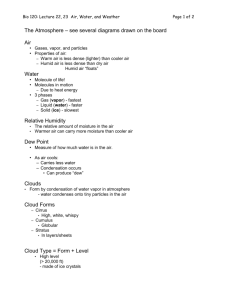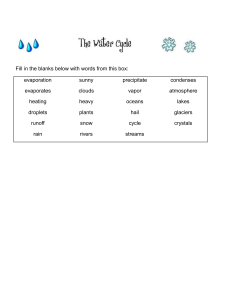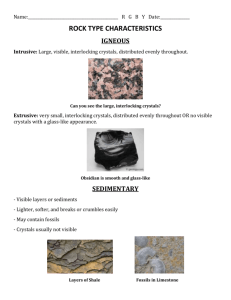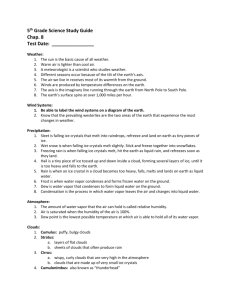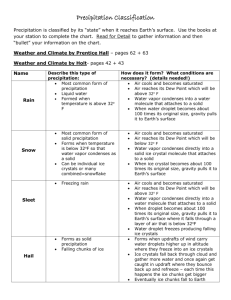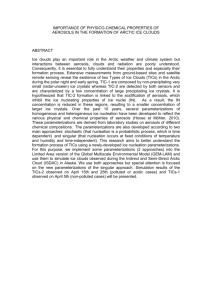Lowen, 2012, Single Scattering Parameters of Cirrus
advertisement
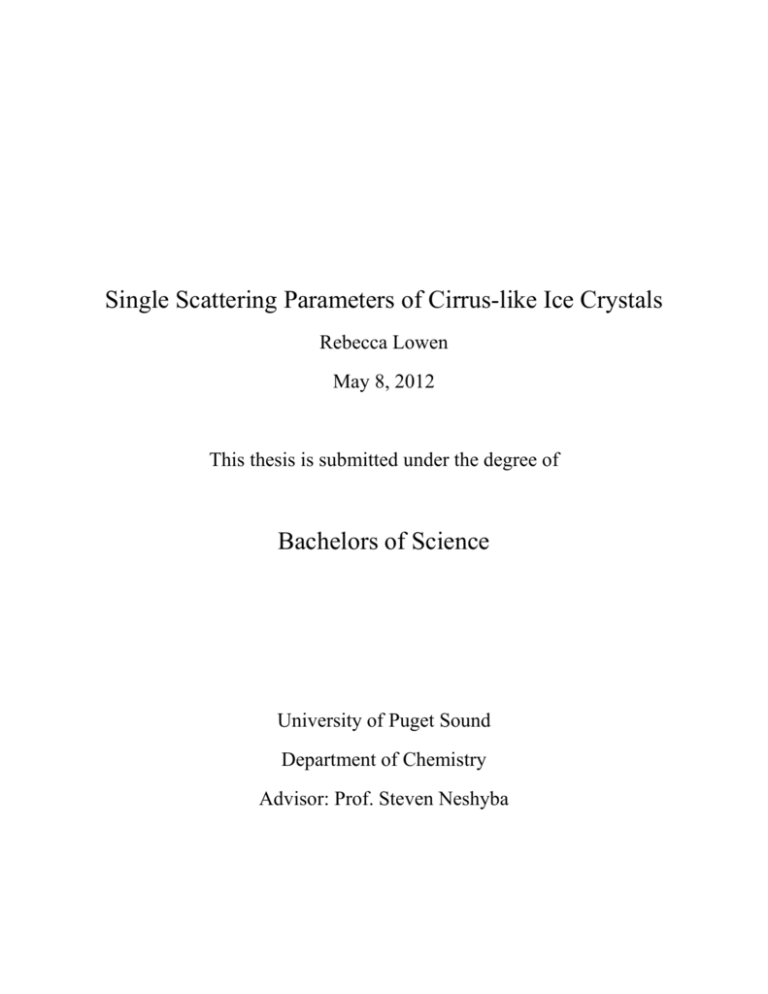
Single Scattering Parameters of Cirrus-like Ice Crystals Rebecca Lowen May 8, 2012 This thesis is submitted under the degree of Bachelors of Science University of Puget Sound Department of Chemistry Advisor: Prof. Steven Neshyba Table of Contents Abstract…………………………………………………………………………………..3 Introduction………………………………………………………………………………3 Experimental……………………………………………………………………………...6 Results and Discussion……………………………………………………………………11 Conclusion………………………………………………………………………………..18 Acknowledgements………………………………………………………………………18 References………………………………………………………………………………...19 2 Single Scattering Parameters of Cirrus-like Ice Crystals *Rebecca Lowen, Steven Neshyba May 8th, 2012 ABSTRACT We present single scattering properties for cirrus-like ice crystals. Ice crystals were grown and imaged in a variable pressure scanning electron microscope equipped with a cold stage. Temperature was adjusted to where the crystals began to sublime. This condition made the ice crystals roughen. Using images of roughened crystals, we came up with metrics for measuring how rough these crystals became. We used these metrics to parameterize a beveled model for the surface roughness. Models for shallow and deep roughening were fed into a ray tracing program. The Ray tracing program produced a phase function and asymmetry parameter. The Asymmetry parameter of cirrus-like ice crystals is applicable to the reflectivity property of cirrus clouds which is important in our understanding of how cirrus clouds effect global warming. INTRODUCTION One reason to study single scattering properties of ice crystals that form in glaciated clouds is to represent the reflective properties of cirrus cloud crystals well enough to be faithfully represented in climate models. Cirrus clouds are thin wispy clouds, 15-20 km high, and are made of ice. Cirrus clouds are climatologically important because they reflect sunlight. Clouds reflect light because individual crystals scatter light. Therefore understanding how single ice crystals scatter light addresses the larger question of how clouds will reflect light. Asymmetry parameter is a single scattering parameter that measures the distribution of scattering of a single ice crystal. If all light is forward scattered, the asymmetry parameter is equal to one. Equally distributed scattering, also called isotropic scattering, will have an asymmetry parameter equal to zero. Therefore, an ice crystal that backscatters more light will 3 have a lower asymmetry parameter. In 2000, images of ice crystals were collected with a CPI in a glaciated cloud (Gerber et. All, 2000) and the asymmetry parameter was found for these aviation photographs. Figure 1. Images of ice crystals collected with the CPI taken in a cirrus cloud. The largest bullet rosette has a maximum diameter of 450 µm. The asymmetry parameter was found to be an average value of 0.75, which meant that glaciated cloud ice crystals backscattered light. However, when raytracing calculations were performed for 4 smooth hexagonal prism models of ice crystals, the asymmetry parameter was found to be equal to 0.85, much less backscatter (Macke et al., 1996). Previous to these discoveries of asymmetry parameters, in the Antarctic winter of 1992, falling ice crystals were collected and photographed with a microscope (Walden et. al., 1992). The optical images collected for these ice crystals from the South Pole showed visible rings. Figure 2. On the left. Photomicrographs of wintertime ice crystals imaged by Walden et. al. On the right. Close up on an ice crystal in image C. The crystals are on a scale of hundreds of micrometers. 5 The following figure shows the published image as well as a close up image of one of the ice crystals. As seen in the close up image on the right, there are visible rings that appear on the ice crystals. The hypothesis for this paper is that Gerber’s observation of greater- than-expected backscatter (g= 0.75) is due to micrometer scale roughening on the ice crystals that Macke’s Raytracing calculations did not account for (g=0.85). Variable pressure SEM (VP-SEM) has recently been explored as a technique for observing surface features at great resolution. We present the study of ice crystals grown inside a VP-SEM chamber of the instrument and imaged as they ablate and grew and have provided VPSEM micrographs showing surface features associated with growth and ablation of hexagonal ice prisms growing on a cold copper substrate. We observe the growth of hexagonal ice crystals that are several hundred micrometers in diameter. Subsequent temperature manipulations allow us to examine the surfaces of these crystals under growth and ablation conditions. EXPERIMENTAL VP-SEM Imaging of Growing and Ablating Ice Crystals. Micrographs were taken using a Hitachi S-3400N VPSEM equipped with a backscattered electron detector and an accelerating voltage at 12 kV. Probe Current was set to 90 Amps and the four central detectors (A, B, C, D) were turned on while the side detector (E) was turned off. BSE Gain 3 (standard) was turned on. A rough-cut copper specimen stub mounted on an examination stage was cooled with a Deben Ultra-Cool stage MK3 version Peltier cooling element. Water vapor was introduced into the chamber by placing a metal reservoir containing 4mL of de-ionized liquid water frozen at -15°C inside the VPSEM chamber. After turning on the evacuation pump, the reservoir with frozen water 6 sublimated. Specimen size was entered (+51mm, +8mm) and then the camera was turned on to raise the stage to 8. Camera was turned off before turning on the accelerating voltage. Once a pressure of 50 Pa was reached, the Peltier cooling system was turned on (red switch behind the box) and then the Temperature was entered to conditions conducive to growing ice crystals (~45°C). The examination stage was then monitored at low magnification (20×) until the first ice crystals were evident. Once ice crystals were detected, an ablation experiment was performed. . The temperature of the examination stage was quickly raised to the ablation onset temperature (32°C), a process requiring at most one minute. Knob settings could be adjusted for better imaging (brightness, contrast, fine focus, coarse focus, magnification) and slower imaging speeds enabled capturing images with better resolution. Temperature then was set to regrow ice crystals (-45°C). Once finished, temperature was increased to a temperature sufficient to melt ice crystals (25°C) and then the cold stage was turned off. The magnification was turned to the lowest magnification. Then the chamber was AIRED and the reservoir and cold stage were removed. Raytracing. Various beveled models designed on MATLAB were made into tps.m files and then run on MATLAB to create .afn files. Then, .afn files were run using Macke’s Raytracing (rt.f90) outputting an input.txt.p11 file which was used to run rungetmompf.f to produce text files containing the asymmetry parameters and phase functions (Macke et al., 1996). 7 Figure 3. Schematic for how p11.txt files and leg files were generated to create the phase function and asymmetry parameter starting with parameters for a hexagonal crystal. 8 Figure 3. This is an example of a hex_tps.afn crystal file with annotated parameters for running raytracing. 9 Figure 5. This screenshot is of the mac xs window showing the various parameters used to run raytracing. 10 RESULTS AND DISCUSSION Interesting images of ice crystals were collected. For the most part, they are hexagonal and have pyramidal facets, basal heads, and trans-prismatic edges. Here are a few interesting images of full grown crystals taken in the SEM. 11 As seen in the images above, there is a multitude of interesting growth and ablation patterns occurring at various levels of the ice crystal. In the first image, two crystals are growing side by side and show clearly the various facets. However in the second image, we can only vaguely make out the pyramidal facets and the trans-prismatic edges. Using an experimental procedure imaging a trans-prismatic edge of an ice crystal imaged under temperature manipulation conditions, roughening was observed. Here are VP-SEM micrographs from growing, ablation, and re-growing ice crystals imaged at a Magnitude of x420. 12 A. B. C. C. D. E. F. G. H. J. K. Figure 6. VPSEM images of Roughening. The chamber was cooled and images were taken for a full grown single ice crystal’s trans-prismatic facet (A-B). Then the crystal was exposed to warming conditions where ablating occurred and roughening was imaged (C-E). The crystal was then re-cooled and imaged (F-H). Close up on Image H, as seen in Figure 6, there is roughening on a scale (µm) which is big compared to visible light (nm) meaning that roughening will scatter light. The apparent heights and amplitudes shown in Figure 7 were used to calculate the apparent and the actual angle. 13 Figure 7. Quantifying parameters of roughening. Six grooves were measured for their peak heights and amplitudes. These measurements were used in the following calculations to determine the angle of roughening. 𝐴= δ = (tan−1( ℎ √3 ∗ 2 2 2∗𝐴∗𝜋 ) ∗ 180)/𝜋 𝜆 The true Amplitude is found using the measured peak height (h). The actual angle of roughening (δ) was then calculated for all six grooves using the true amplitude. The average angle was 35° ±3 with a 95% confidence interval of 4°. In order to measure the extent to which roughening, as 14 observed in the VP-SEM, scatters light, a beveled model was created using a conservative angle of 25° as seen in Figure 8. Figure 8. Beveled model (a=5, c=40). One million photons were fired at the model for both deep and shallow roughening angles and a phase function was produced as seen in Figure 9. 15 Figure 9. Phase Function comparing smooth with deep and shallow roughening exemplars. The Phase Function measures the intensity of light scattering at various angles for the three models. Front scattering occurs from 0° to 90° and backscattering occurs from 90° to 180°. Roughened models, as seen by the dotted lines, seem to backscatter more light than the smooth model. 16 Figure 10. Asymmetry Parameter for various degrees of Roughening. There is a decreasing trend in the asymmetry parameter with more roughening as seen in Figure 10. Roughening is measured as δb. For every model, the asymmetry parameter declines with greater degrees of roughening meaning that roughening lowers the asymmetry parameter. Incorporating roughening could mean up to 20% more reflection of sunlight in cirrus clouds (Neshbya’s Calclation). As the temperature increases, crystals become rougher and they in turn backscatter more light. Therefore, as clouds age, they will become more and more reflective. 17 CONCLUSION VP-SEM imaging allows for greater resolution images of growing and ablating ice crystals that can allow for the patterns of roughening to be measured and even quantified as done in this thesis paper. Roughening occurred most noticeably on the onset of ablation which is consistent with other research (Pfalzgraff, Hulscher, Neshyba). Future research could look at how roughening occurs on other facets of the ice crystal including the basal head, pyramidal facet, and conical non-faceted surface described in research done by Pfalzgraff, Hulscher, and Neshyba. Also, looking at the differences in roughening for various pressures could provide insight for the effect of pressure on roughening inside the SEM chamber. Hopefully the present research and future research describing ice crystal behavior will offer insight into the microstructures of cirrus clouds that will assist climatologists in work towards understanding clouds and their effect on climate change. ACKNOWLEDGEMENTS I would like to give a special thank you to Steven Neshyba, my thesis advisor, for all of the help and support this year. Thank you to Daniel Guilack for his help teaching me about computer languages and Courtney Lavalle all her help with working and fixing the SEM. Thank you to Mitch Benning for being awesome. 18 REFERENCES Gerber, H., Takano, Y., Garrett, T.J., and Hobbs, P.V.: Nephelometer Measurements of the Asymmetry Parameter, Volume Extinction Coefficient, and Backscatter Ratio in Arctic Clouds, J. Atmos. Sci. 57, 3021-3034, 2000. Macke, A., Mueller, J., Raschke, E.: Single Scattering Properties of Atmospheric Ice Crystals, J. Amer. Meteor. 1996. Pfalzgraff, W.C., Hulscher, R.M., Neshyba, S.P.: Scanning Electron Microscopy and Molecular Dynamics of Surfaces of Growing and Ablating Hexagonal Ice Crystals, J. Atmospheric Chemistry and Physics. 2009. Walden, V.P., Warren, S.G., and Tuttle, E.: Atmospheric Ice Crystal over the Antarctic Plateau in Winter, J. Appl. Meteor., 42, 1391-1405, 2003. 19
